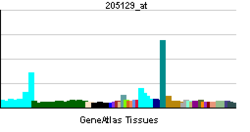- NPM3
-
Nucleophosmin/nucleoplasmin 3 Identifiers Symbols NPM3; PORMIN; TMEM123 External IDs OMIM: 606456 MGI: 894653 HomoloGene: 5083 GeneCards: NPM3 Gene Gene Ontology Molecular function • nucleic acid binding Cellular component • nucleus
• nucleolusBiological process • rRNA processing
• rRNA transcriptionSources: Amigo / QuickGO RNA expression pattern 
More reference expression data Orthologs Species Human Mouse Entrez 10360 18150 Ensembl ENSG00000107833 ENSMUSG00000056209 UniProt O75607 Q3TAH3 RefSeq (mRNA) NM_006993 NM_008723.1 RefSeq (protein) NP_008924 NP_032749.1 Location (UCSC) Chr 10:
103.54 – 103.54 MbChr 19:
45.82 – 45.82 MbPubMed search [1] [2] Nucleoplasmin-3 is a protein that in humans is encoded by the NPM3 gene.[1][2]
The protein encoded by this gene is related to the nuclear chaperone phosphoproteins, nucleoplasmin and nucleophosmin. It is highly homologous to the murine Npm3 gene. Based on the structural similarity of the human NPM3 gene product to nucleoplasmin and nucleophosmin, NPM3 may represent a new member of this gene family, and may share basic functions with the molecular chaperones.[2]
References
- ^ Shackleford GM, Ganguly A, MacArthur CA (Jul 2003). "Cloning, expression and nuclear localization of human NPM3, a member of the nucleophosmin/nucleoplasmin family of nuclear chaperones". BMC Genomics 2: 8. doi:10.1186/1471-2164-2-8. PMC 60000. PMID 11722795. http://www.pubmedcentral.nih.gov/articlerender.fcgi?tool=pmcentrez&artid=60000.
- ^ a b "Entrez Gene: NPM3 nucleophosmin/nucleoplasmin, 3". http://www.ncbi.nlm.nih.gov/sites/entrez?Db=gene&Cmd=ShowDetailView&TermToSearch=10360.
Further reading
- Philpott A, Krude T, Laskey RA (2000). "Nuclear chaperones.". Semin. Cell Dev. Biol. 11 (1): 7–14. doi:10.1006/scdb.1999.0346. PMID 10736259.
- Olsen JV, Blagoev B, Gnad F, et al. (2006). "Global, in vivo, and site-specific phosphorylation dynamics in signaling networks.". Cell 127 (3): 635–48. doi:10.1016/j.cell.2006.09.026. PMID 17081983.
- Andersen JS, Lam YW, Leung AK, et al. (2005). "Nucleolar proteome dynamics.". Nature 433 (7021): 77–83. doi:10.1038/nature03207. PMID 15635413.
- Gerhard DS, Wagner L, Feingold EA, et al. (2004). "The status, quality, and expansion of the NIH full-length cDNA project: the Mammalian Gene Collection (MGC).". Genome Res. 14 (10B): 2121–7. doi:10.1101/gr.2596504. PMC 528928. PMID 15489334. http://www.pubmedcentral.nih.gov/articlerender.fcgi?tool=pmcentrez&artid=528928.
- Strausberg RL, Feingold EA, Grouse LH, et al. (2003). "Generation and initial analysis of more than 15,000 full-length human and mouse cDNA sequences.". Proc. Natl. Acad. Sci. U.S.A. 99 (26): 16899–903. doi:10.1073/pnas.242603899. PMC 139241. PMID 12477932. http://www.pubmedcentral.nih.gov/articlerender.fcgi?tool=pmcentrez&artid=139241.
- Andersen JS, Lyon CE, Fox AH, et al. (2002). "Directed proteomic analysis of the human nucleolus.". Curr. Biol. 12 (1): 1–11. doi:10.1016/S0960-9822(01)00650-9. PMID 11790298.
- MacArthur CA, Shackleford GM (1997). "Npm3: a novel, widely expressed gene encoding a protein related to the molecular chaperones nucleoplasmin and nucleophosmin.". Genomics 42 (1): 137–40. doi:10.1006/geno.1997.4353. PMID 9177783.
Categories:- Human proteins
- Chromosome 10 gene stubs
Wikimedia Foundation. 2010.
